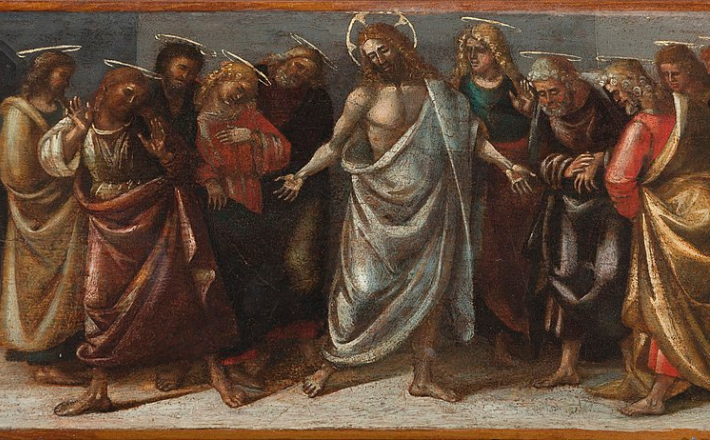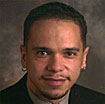Commentary on John 20:19-31
Fear can be paralyzing. We often associate fear with the fight-or-flight impulse, but paralysis is typical for humans responding to feeling overwhelmed. In this case, the disciples are hiding in a house because of “the fear of the Jews” (John 20:19). They hid behind “shut,” maybe locked, doors. It was the evening of the “first day of the week” (20:19). This was after Jesus’ appearance to Mary Magdalene at the tomb much earlier that day (20:1). She was the first to proclaim the resurrection (20:18).
Reassurance is an antidote to fear. It serves as a way for humans to confront the unknown in a way that moves them from paralysis to action. The presence of Jesus among the disciples provides the reassurance they need. In the middle of their fear, Jesus speaks of peace. “Peace be with you” is his address to his followers (20:19). It is rooted in the Jewish concept of shalom, an attribute often associated in Hebrew literature with God (Judges 6:24).
The Greeks and the Romans associated the idea of peace with the inner nature of human beings frequently connected to the absence of conflict or war. The Hebrews, by contrast, tended to use the term primarily for interpersonal or social relations, where it comes very close to meaning justice. When justice is done, it is seen as God’s gift to the people, and prosperity comes to the people when they live faithfully under the divine covenant.
In early Christian literature, peace (eirēnē) is often used as a greeting, as in this text. It can also be used as a word of departure (for example, Mark 5:34). Here, it is intimately connected to Jesus. Peace is used sparingly in this Gospel. It is related to the commission to forgive sins (John 20:23). Before his crucifixion, Jesus promises his disciples: “Peace I leave with you, my peace I give to you, the kind of peace the world cannot give” (14:27). This peace is meant to enable them to overcome their fear and move forward in the power of the Holy Spirit (20:22).
Unfortunately, the difference between Jesus’ peace and the world’s peace is never really explained in John. The closest we may come to understanding John’s idea of peace is found in 16:33: “I have said this to you, that in me you may have peace. In the world, you have tribulation, but be of good cheer; I have overcome the world.” The Roman peace (pax Romana) was enforced by violence. It was the absence of conflict through military conquest, surveillance, and oppression. Christ’s peace comes from the victory over evil through the absorption of suffering.
Reassurance also comes through revelation. Christ shows the disciples his wounded hands and side (20:20). It is an intimately personal experience. In the preceding pericope, the resurrected Jesus reveals himself to Mary one-on-one. In this text, he shows himself to an unnamed number of disciples in a private residence. Through the presence of the risen Christ, the disciples are empowered to continue Jesus’ ministry through the reception of the Holy Spirit (20:22).
Thomas is a curious figure. He appears in four passages in this Gospel (11:16; 14:5; 20:24-28; 21:2). In three passages, he is called the twin (11:16; 20:24; 21:2). The Greek word for “twin” (didymos) was widely known as a form of designation for individuals. John, however, tells us nothing about Thomas’ twin, and does not tell us how he acquired this title. His declaration to the other disciples that until “I see in his hands the print of the nails, and place my finger in the mark of nails, and place my hand in his side, I will not believe” over time garnered him the distinction of being a doubter (20:25). It may be an unfair designation, given that John portrays Thomas as representative of the disciples generally.
Thomas is chosen from among the disciples to dramatize the group’s disbelief. This refusal to recognize the reality of the resurrection is a common feature of the gospel tradition (Matthew 28:17; Mark 16:11, 14; Luke 24:36-43). In today’s text, Thomas was not present when Jesus first appeared to the disciples on that evening eight days earlier. They tell Thomas they have seen the risen Lord, but Thomas demands physical proof.
Jesus appeared to the disciples, who “were glad when they saw the Lord” (John 20:20). Later, in the same house, Jesus satisfies Thomas’ request for proof but says to him, “Do not be faithless, but believing” (20:27). Thomas’ response is a confession of faith. Jesus goes on to encourage those who believe without experiencing the presence of the resurrected Christ. The presence of the Holy Spirit substitutes for the presence of the risen Jesus.
In an interesting twist to the story, Thomas’ confession is the only declaration of the divinity of Jesus in the Gospel. He serves as a bridge between the past of experiencing the presence of Jesus and the future of living with the presence of the Holy Spirit. Thomas should have believed because he heard the testimony of the other disciples. He, however, demands physical reassurance of the resurrection. He then serves as a foil for those who believe without the benefit of an explicit revelatory experience. Jesus praises them: “Blessed are those who have not seen and yet believe” (20:29).
The Gospel then provides a preliminary ending following Thomas’ confession of the risen Jesus as “my Lord and my God” (20:28). Unlike the disciples and Thomas, who experience the presence of the risen Christ, future believers are encouraged to believe because of the written word and the presence of the Holy Spirit in the ministry of his disciples (20:31).



April 7, 2024